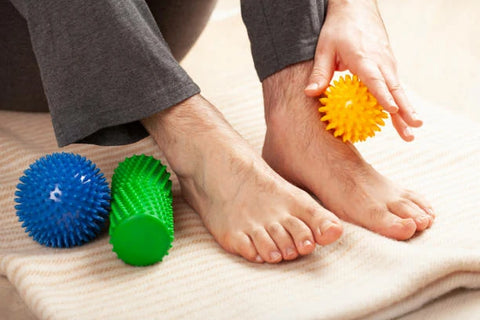Using A Golf Ball to Massage Feet
In a breakthrough development set to revolutionize the world of foot massages, a novel technique involving the use of a golf ball has emerged as an effective, affordable, and readily accessible solution for self-foot care. Offering unparalleled benefits that go beyond the conventional foot massagers available on the market, this innovative approach has been hailed by experts as a game-changer in promoting relaxation, relieving pain, and fostering overall well-being.

Developed on the premise of combining two popular activities – golf and self-care – the golf ball technique aims to leverage the inherent qualities of a standard golf ball for exceptional feet massage. The unique dimpled surface of a golf ball has been found to target key pressure points on the foot, providing therapeutic benefits similar to those achieved through professional massages.
Traditional foot massages can be costly, time-consuming, and out of reach for many individuals, especially amidst the current global scenario. The golf ball technique brings relief by offering a simple yet impactful solution that can be easily adopted by people of all ages in the comfort of their own homes. With an average cost of just a few dollars, a golf ball becomes an inexpensive investment in overall well-being.
This innovative practice has garnered significant attention from enthusiasts across the globe. Notable health and wellness experts recognize its potential to provide immediate relief from foot discomfort, reduce muscle tension, and enhance blood circulation. By employing a golf ball in a systematic manner, users can personalize the massage intensity according to their preferences, ranging from gentle rolling to deep tissue stimulation.
Dr. Rachel Johnson, a renowned podiatrist, praised the golf ball massage technique, stating, "It is truly remarkable how a simple object like a golf ball can help ease foot-related ailments. Rolling your feet on a golf ball not only stimulates sensory receptors in the feet but also helps release tight muscles and fascia. It is particularly useful for individuals who suffer from plantar fasciitis, arch pain, or simply want to relax after a long day.”
The therapeutic effects of the golf ball technique are not limited solely to physical benefits. Numerous studies have highlighted the connection between foot massages and mental well-being. This technique, by stimulating reflex zones on the feet, has shown potential to enhance relaxation, reduce stress, and improve overall mood. Whether it is for athletes seeking post-training recovery, professionals experiencing prolonged periods of standing, or individuals simply seeking relaxation, the golf ball technique offers a holistic approach to foot care.
To enjoy the full therapeutic benefits of the golf ball technique, it is recommended to follow a simple step-by-step process:
1. Find a comfortable seated or standing position.
2. Place the golf ball on the floor or any flat surface, applying light pressure with the foot.
3. Roll the ball slowly back and forth, from the heels to the toes, pausing at any tender spots or areas of discomfort.
4. Repeat the rolling motion for the desired duration, typically 5-15 minutes per foot.
5. Adjust the intensity of the massage by regulating the applied pressure and speed of rolling.
It is important to note that individuals with pre-existing foot conditions or injuries should consult with a healthcare professional before incorporating the golf ball technique into their self-care routine.
The golf ball technique beautifully demonstrates how everyday objects can be repurposed for innovative self-care practices, addressing various aspects of physical and mental health. As individuals worldwide adapt to evolving circumstances and prioritize well-being, the golf ball technique has emerged as a cost-effective and accessible solution for self-foot care. By embracing this innovative approach, people can experience invigorating foot massages wherever and whenever they desire, bringing unparalleled benefits to their overall happiness and quality of life.








